Grown for its large fiddle-shaped leaves, the fiddle leaf fig plant is one of the most popular houseplants and has been for many years. It is fairly easy to care for, and can grow up to 10 feet tall. It makes a stunning addition to any room.
If you want to properly care for your houseplant, you will need a fiddle leaf fig plant care guide. The guide will discuss the proper growing requirements for this tropical houseplant.
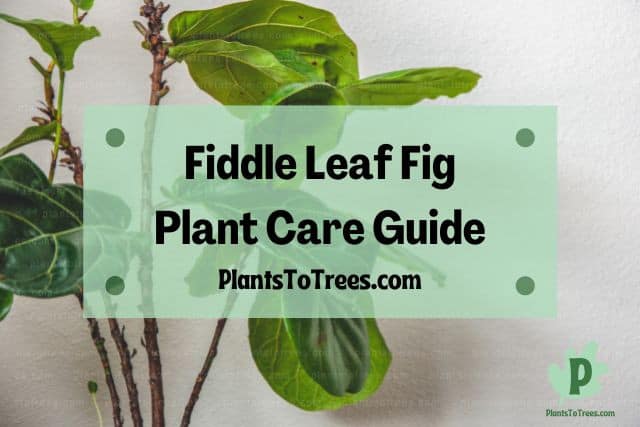
Every plant has its own set of specific growing requirements that you will need to meet if you want to succeed in growing the plant. For example, the fiddle leaf fig plant cannot grow in USDA hardiness zones below zone 9, and trying to plant it outdoors in one of these lower zone areas will result in the death of the plant.
The fiddle leaf fig plant will also need a combination of direct and indirect light. While this requirement isn’t too difficult to achieve, it could be a first for indoor gardeners who are used to supplying either direct or indirect for their other plants.
Because they are tropical plants, the fiddle leaf fig will need warm temperatures throughout the entire year. Aim for temperatures that fall between 65 and 85 degrees, and avoid allowing the plant to sit at temps that are 60 degrees or below for an extended period of time.
While most indoor humidity levels work fine for this plant, if you can keep the percent to 50 or above, your fiddle leaf fig will thrive. You can easily increase the humidity levels around your fiddle leaf fig by sitting the plant on a drip tray. These are shallow trays filled with pebbles.
When you water the fiddle leaf fig plant, the excess water will drain out of the bottom of the pot and into the drip tray. This water will then naturally evaporate into the air around the fiddle leaf fig plant, which then increases the humidity level.
Another option is to use a humidifier turned on in the same room as the fiddle leaf fig.
Fiddle leaf fig plants don’t like soggy feet, so you will need to ensure you are not overwatering them, and that they are growing in a pot that has proper drainage holes and soil that is light and airy.
Despite these few requirements, the fiddle leaf fig is a good choice for beginners who are just starting their journey into the world of houseplants. Their growing needs are not too outrageous, and can be easily handled by even the most novice gardener.
Other Names Of Fiddle Leaf Fig Plant
Most plants go by more than one name. In fact, there are some plants that have multiple different names, and these names can change depending on the area. But what about the fiddle leaf fig plant? Is it known by any other name?
While most people know it as the fiddle leaf fig plant, this popular houseplant is also called fiddle fig tree and fiddle leaf tree, and its scientific name is Ficus lyrata. No matter what you call it, with the proper fiddle leaf fig plant care guide, it is sure to bring you years of joy.
Frost Tolerance And USDA Hardiness Zones Of Fiddle Leaf Fig Plant
The frost tolerance and USDA hardiness zones of any plant, not just the fiddle leaf fig, is vital information that you as a gardener should know. Trying to grow a plant outdoors in an area where it cannot handle the climate is one of the quickest ways to kill the plant.
Fiddle leaf fig plants are not frost tolerant, but they can grow in USDA Hardiness Zones 9 to 11. These tropical plants don’t do well in temperatures below 50 degrees Fahrenheit for an extended period of time. Their optimal growing range is between 60 and 75 degrees.
Not sure what USDA plant hardiness zone you live in? Check with the USDA plant hardiness zone map. It will tell you exactly what zone you are in. Another option is to reach out to your local nursery for assistance. Since they work with plants in your area, they should know the USDA hardiness zone.
How Many Hours Of Sunlight Does Fiddle Leaf Fig Plant Need?
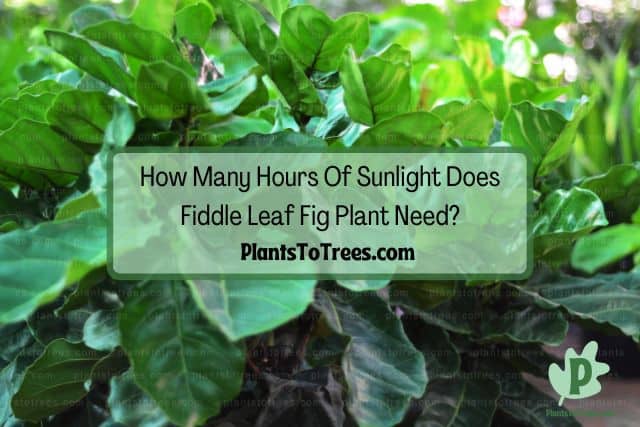
Fiddle leaf figs don’t require an over abundance of sunlight, which is a good thing if you are limited in the amount of available windows you have in your home. That doesn’t mean you should put the plant in a dark corner where it won’t get sunlight.
Fiddle leaf fig plants are sun-loving plants that need 6 to 8 hours of light every day. Not giving them the proper amount of sunlight can cause the fiddle leaf fig plant to experience yellowing leaves, which can also fall off the plant, and brown spots.
Fiddle Leaf Fig Plant Needs Direct Or Indirect Sunlight?
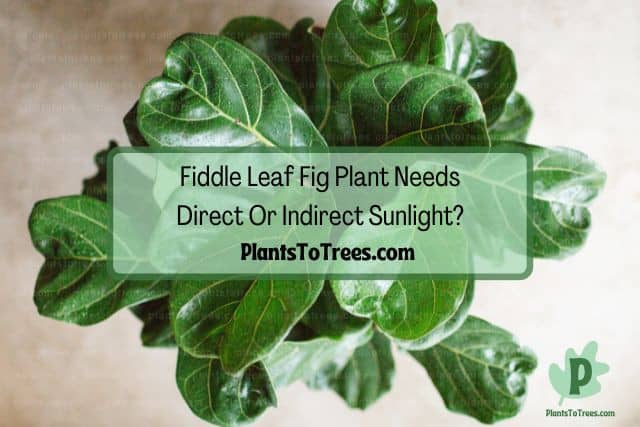
For people who are new to growing plants indoors, learning the difference between direct and indirect sunlight isn’t difficult. But fiddle leaf figs require a bit more than just one or the other. They need a little of both.
Fiddle leaf fig plants can grow in both direct and indirect sunlight, although you need to ensure they get the right amount of direct light as too much can cause problems. They thrive when they get the direct morning sun, and then the bright indirect sunlight for the remainder of the day.
Placing the fiddle leaf fig plant close to a west or south-facing window, or directly next to an east-facing window are perfect places for your plant to grow. Just make sure no objects, such as trees or structures, are blocking the sunlight from entering the window.
Is Fiddle Leaf Fig Plant An Indoor Plant, Outdoor Plant Or Both?
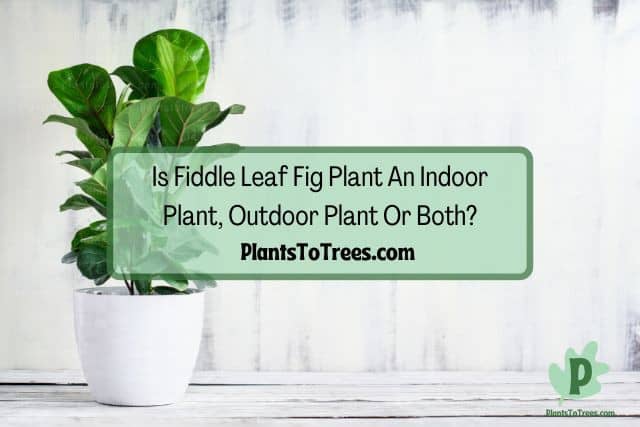
Most plants can grow both indoors and outdoors, as long as they are given the correct climate and growing requirements.
In most areas, the fiddle leaf fig is grown indoors as a houseplant. This is because the majority of places in the United States do not have the warm, year-round temperatures that this tropical plant needs. If, however, you live in USDA hardiness zones 9 to 11, you can grow this plant outdoors.
If you live in a zone outside of 9 to 11, you can still move your fiddle leaf fig outside when the weather is warm and mild, such as during late spring, summer, and possibly even early fall. Make sure you move the fiddle leaf fig back inside before the temperatures start to move closer to 60 degrees.
What Are The Indoor Lighting Requirements of a Fiddle Leaf Fig Plant?
Even though fiddle leaf figs are not too picky when it comes to lighting, it is still best to try to give them their ideal lighting requirements. This will simply help to keep the plant as strong and healthy as possible.
Place your fiddle leaf fig in an area where it will receive both direct and indirect light. A location where they can get bright direct morning sun that turns to indirect light as the hours pass is the ideal location for your indoor fiddle leaf fig plant.
Indoor lighting requirements can pose a challenge for some. After all, not everyone has unlimited space in their homes, or access to windows that provide the perfect amount of light. If you’re one of the many that cannot give the fiddle leaf fig the proper amount of light from windows, consider supplementing the sunlight with artificial lights.
What Are The Outdoor Lighting Requirements for a Fiddle Leaf Fig Plant?
The lighting requirements for growing fiddle leaf figs outdoors is pretty much the same as if you were growing the plant outdoors.
When growing your fiddle leaf fig plant outdoors, you will need to choose a spot where the plant will receive bright, indirect sunlight. The plant should also be protected from strong winds and heavy rain.
The simple fact is that, in most cases, the lighting requirements for a plant doesn’t change depending on if it is grown indoors or outdoors.
What Soil Requirements Does Fiddle Leaf Fig Plant Need?
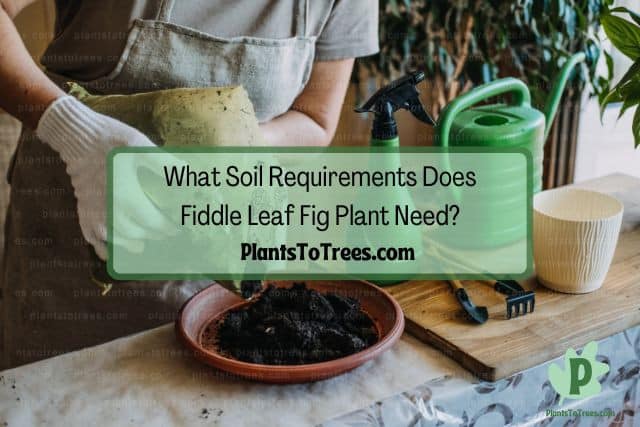
Soil can make or break the health of the fiddle leaf fig. Choosing the wrong soil can leave the roots soggy and the plant susceptible to fungal disease.
Fiddle leaf fig plants need potting soil that has a high amount of organic matter and is also well draining. A good option is to mix 1/3 perlite with 2/3 peat moss. Most indoor potting mixes will also work well for fiddle leaf figs.
While you should always strive to give the plant the best soil possible, try not to be too worried if you plant the fiddle leaf fig in the wrong soil. You can always repot the plant in the correct soil at anytime.
How Much Water Does Fiddle Leaf Fig Plant Need?
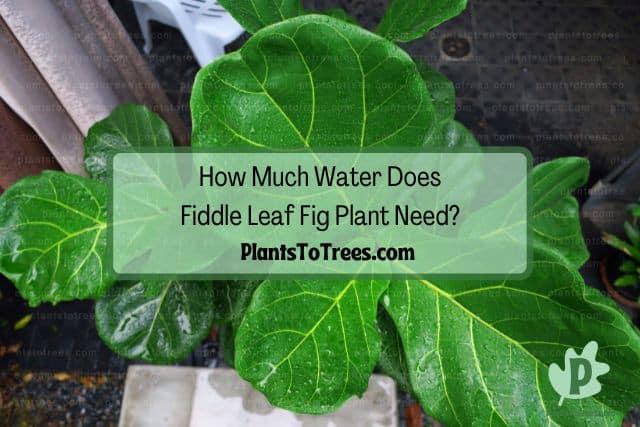
The amount of water your fiddle leaf fig plant needs is an important part of the plant-care process.
The fiddle leaf fig plant needs water about once every 7 to 10 days, though this can vary based on several factors. The best thing to do is to check the top few inches of soil for dryness and then water as needed. If the soil still feels moist, wait a few days before checking it again.
One of the quickest ways to kill your fiddle leaf fig plant is to overwater it. Before you water the plant, insert your finger a few inches into the soil and only water if it feels dry. This simple act will go a long way to prevent overwatering.
Is My Fiddle Leaf Fig Plant Overwatered, What Are The Symptoms?
No matter what plant you are growing, overwatering it opens it up to a wide array of problems, including fungal diseases. That is why it is important to take care not to keep the plant’s roots soggy.
When you overwater your fiddle leaf fig plant, it will start to develop brown spots or discolorations near the middle of the leaves, as well as along the edges. It can also start to yellow and its leaves begin to drop off.
If not corrected, overwatering will lead to root rot and other potentially fatal diseases. Immediately stop watering the plant if it has been overwatered, and wait until the first few inches of soil are dry before you start watering it again.
If, however, the plant has been overwatered for a while, the fiddle leaf fig will need to be removed from its pots, the soggy soil discarded, and then repotted into a sanitized container with fresh soil.
Is My Fiddle Leaf Fig Plant Underwatered, What Are The Symptoms?
While giving the plant too much water is a bad thing, so is not giving your fiddle leaf fig enough hydration. The only good thing about underwatering, however, is that in most cases the plant can recover from it.
Underwatering the fiddle leaf fig plant will result in the leaves curling at the edges, turning brown, and having a crispy feeling. The leaves will also begin to fall off the plant, and the soil will be hard, compact, and dry.
To fix an underwatered fiddle leaf fig plant, it will need to soak in a bucket of water. Submerge the plant’s container in water and let it soak for 30 minutes. When you lift the plant out of the bucket, allow the excess water to drain out of the container’s drainage holes before setting the plant back in its location.
How Much Fertilizer Does Fiddle Leaf Fig Plant Need?
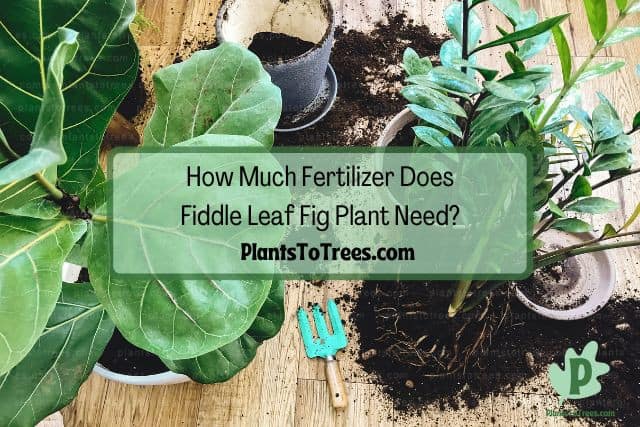
A lot of people who grow indoor plants don’t even consider feeding their plants. This is a shame since most plants, even those grown indoors, could really benefit from fertilizer every once in awhile.
Fiddle leaf figs need a fertilizer that is high in nitrogen applied once a month during its active growing season, which is the summer. A liquid fertilizer works best since it can be added to water and applied at the same time as you water the fiddle leaf fig.
If you’re unable to find the right fertilizer for your fiddle leaf fig, speak to an associate at your local garden center. They can assist you in finding the perfect fertilizer for your fiddle leaf fig.
Fiddle Leaf Fig Plant Diseases To Be Aware Of
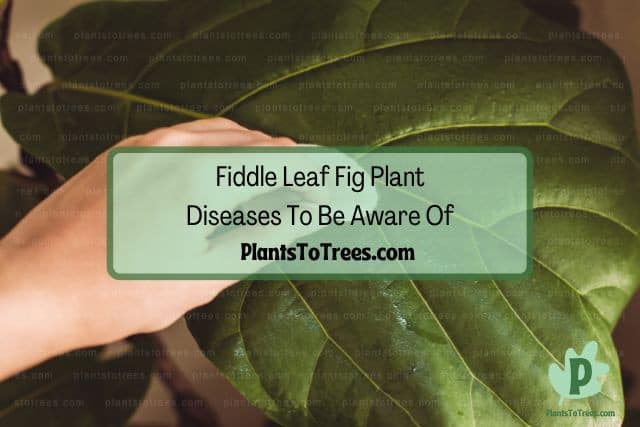
Even though houseplants usually don’t have to deal with as many diseases as outdoor plants, there are still some problems that can arise that pose a risk to your fiddle leaf fig.
While fiddle leaf figs don’t have too many disease problems, they are susceptible to root rot. Root rot occurs when the roots are growing in soggy soil. This can be due to overwatering, poor soil drainage, or a combination of both.
Once the fiddle leaf fig has developed root rot, trying to save it is extremely difficult. Because of this, it is best to prevent root rot in the first place. Thankfully, root rot is very preventable. All you have to do to keep this problem at bay is to make sure the plant is growing in well-drained potting soil in a pot that has drainage holes at the bottom, and never overwater the plant.
Bacterial blight is one problem that can affect the fiddle leaf fig. It occurs when the plant has experienced high temps and high humidity. You will begin to notice red or black spots on the root and crown of the plant. These spots can also have a rotting appearance. The leaf stems of the fiddle leaf fig may also have a greasy look to them. To control this bacterial disease, remove all infected plant parts and treat with fungicide.
Another blight problem that can attack the fiddle leaf fig is botrytis blight. Like with bacterial blight, this problem is caused by high humidity and improper airflow. One of the first symptoms of this blight is water-soaked spots forming on the plant’s stems and leaves. The only way to stop the spread is to remove all leaves and stems that are infected and then treat with a fungicide.
Are There Different Types Of Fiddle Leaf Fig Plant?
Not all fiddle leaf figs are the same. In fact, there are several different types of fiddle leaf figs out there that you can choose from. Knowing the difference will help you make a more informed decision on which one is right for you.
There are 4 different varieties of fiddle leaf fig plants: fiddle leaf fig (Ficus lyrata), dwarf fiddle leaf fig (Ficus lyrata ‘bambino’), compact fiddle leaf fig (Ficus lyrata ‘compacta’), and variegated fiddle leaf fig (Ficus lyrata ‘variegata’).
The traditional fiddle leaf fig is the one most people are familiar with. It has large, fiddle-shaped foliage and can reach heights of about 10 feet tall.
Dwarf fiddle leaf figs are not only smaller in height than the original fiddle leaf fig, but it also has smaller leaves that are more round and don’t have that same fiddle shape that the traditional fig tree has.
The compact fiddle leaf fig plant looks about the same as the traditional fiddle leaf fig, except it has a smaller stature. The compact variety reaches only about 4 feet tall at the plant’s maturity. This is a wonderful option for those who want a fiddle leaf fig but don’t have the room for that large of a plant.
Variegated fiddle leaf fig has the same large, deep green foliage that the original fiddle leaf has, but with cream, yellow, or white margins. It has the same care requirements as well, expect that the variegated variety will need a little bit more light than the original fiddle leaf fig.
How To Propagate Fiddle Leaf Fig Plant
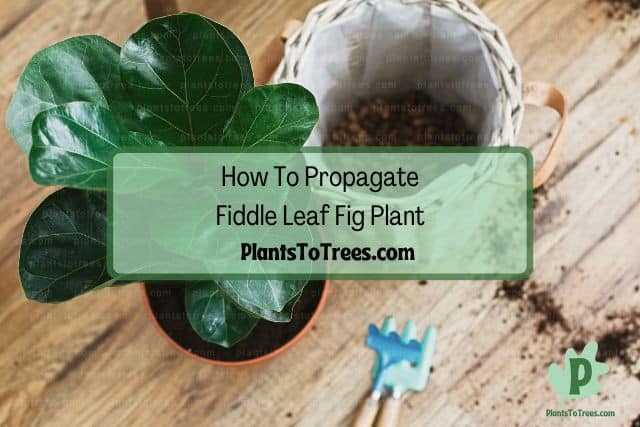
Fiddle leaf figs are relatively easy to propagate, and when you prune the plant to control its height or width, you can merely reuse the snipped off pieces to make new fiddle leaf fig plants.
We at Plants To Trees first published this article on August 22, 2022. Copyright protected.
To propagate the fiddle leaf fig, first choose a healthy stem that has at least one node but preferably two to three nodes. Dip the cutting in rooting hormone to help encourage root development and then plant it in a container filled with potting soil.
Set the fiddle leaf fig cutting in an area where it will receive indirect but bright light. Cover the cutting with a clear plastic bag, using sticks or other items to keep the bag off the leaves, and then mist inside the bag once a day. Root should begin to form after 4 to 6 weeks.
Is Fiddle Leaf Fig Plant Toxic To Humans?
While most adults don’t want to put their fiddle leaf fig in their mouth, you cannot say the same thing about babies and toddlers. They seem to want to put everything in their mouths. That is why it is vital for anyone with little ones to find out whether or not the plant is toxic to humans before deciding to have it as a houseplant.
Fiddle leaf figs are toxic to humans, but taking a bite out of this plant usually won’t kill an adult or cause potentially deadly side effects. It can, however, cause unpleasant symptoms, such as irritation to the mouth, throat, lips, and stomach.
Simply touching the plant’s sap can cause skin irritation and burning. The fiddle leaf fig contains calcium oxalate, which is the toxic compound that causes all the problems.
The article owner is Plants To Trees dot Com and this article was first published on August 22, 2022.
Is Fiddle Leaf Fig Plant Toxic To Dogs?
Dogs are man’s best friend, but they are also nosey creatures that can get themselves in all kinds of trouble. One way is by chewing on things they shouldn’t be, such as houseplants. While this may seem more of an annoyance than anything else, it can actually harm your pooch’s health. There are an abundance of plants commonly grown indoors that can be extremely harmful to your dog if they ingest it.
Fiddle leaf fig plants are toxic to dogs. If your pooch consumes any portion of the plant, they can experience symptoms, such as burning or irritation of the mouth, lips, gums, throat, and stomach, excessive drooling, vomiting, and diarrhea.
In extreme cases, the fiddle leaf fig plant has the potential to cause life-threatening damage to your dog’s organs. If your dog has chewed on a fiddle leaf fig, seek immediate medical attention for them.
Is Fiddle Leaf Fig Plant Toxic To Cats?
Cats are curious animals, and they are known for getting into things they should. It is not uncommon to hear about a cat knocking over houseplants and chewing on their leaves. And while knocking the houseplants over is annoying, the real threat to your kitty is them chewing on the plant. This is because a lot of popular houseplants actually pose a serious threat to your furry feline.
Fiddle leaf fig plants are toxic to cats, and can result in various unpleasant symptoms and even has the potential to cause serious and potentially deadly consequences. The most common symptoms, however, are irritation of the mouth, lips, throat, and stomach.
It can also cause excessive drooling, weakness, breathing problems, and lethargy. If your cat has consumed any part of the fiddle leaf fig plant, immediately contact a veterinarian or poison control for assistance.
Related Articles
PlantsToTrees.com is the owner of this article and we first published this on August 22, 2022.
